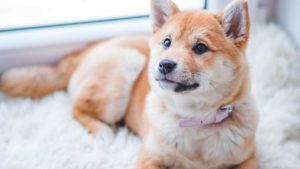My blended family is a bunch of big, gooey dog lovers.
From when I was a newborn until now, I have lived with dogs all my life.
One of my first childhood dogs, Dargon (A Basset Hound), was the most divine friend. Wherever I went, he went, and vice versa. He arrived on a big truck. My dad found him from a breeder near my state’s capital city. He asked Mr. Heath (a local driver) to bring him home on one of his runs. This tiny little dog was sitting in the cab of a big B Double.
I can remember his big floppy ears and clumsy feet. His ears were so limp that he would trip over himself when he ran and get caught up in a confused rolly polly muddle of fur and paws, usually ending in a puddle of mud or a patch of red dirt.
My father knew that if he came out to the big farmyard calling for me and I did not appear, he would locate me once he found Dargon. If Dargon did not come to his whistles, he would more than likely find both of us under the trees in the shade. I would be asleep on Dargon’s belly, and Dargon would lift his head to look at Dad. Dargon would not move until I moved.
Table of Contents
I used to bury Dargon—everything but his head—in the sandpit.
As a young child, I could pull his ears and lie on him, and it didn’t bother him for a second. He was my best friend.
I remember the day that dad came home with tears in his eyes. I was about 10, and Dargon had gone to the neighbouring farm and ate some bad food. It resulted in a twisted bowel, and he passed away before we got him to the vet several kilometres away.
As a person who has had doggy friends, I can say they played a significant part of my world for the majority of my life. It felt only natural for me that it would be the same for my children. But there was one striking difference. It wasn’t me being introduced to a dog this time; it was me introducing my children to my existing and new dogs. I knew that this required lots of consideration.
Having a dog isn’t just about the joy that it brings to your family; it is also about the joy that your family can bring to the dog. It is a mutual relationship, and it comes with challenges as well as great times.
You need to consider the safety, the suitability and the needs of both the children and the dog.
Always remember that your child’s safety is paramount. You MUST be 100 percent confident in bringing a baby home to a dog and vice versa. You can hire a professional to help you train your dog. If you are not 100 percent confident that your dog is safe to be around the baby and you have control of the dog, unfortunately, looking for another home may be a decision you will have to make.
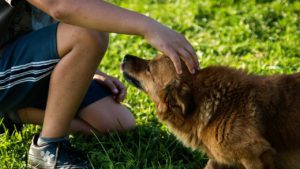
Benefits of Your Children Having a Dog
It Teaches Your Child Responsibility
Having a doggie friend and family member can be a great way to introduce responsibility to your child. Your child can help out, share or be in charge of some of the duties associated with having a dog.
There is a lot that you can choose from, and you need to consider your child’s age and capability so that you are realistic with your expectations of what they are and are not to do. These include feeding, exercising, grooming and hygiene.
You may have teenagers that have a dog that they consider to be theirs. Are they in a position to help out with the costs of the dog or will you be taking this on? How will they budget or make sure they can uphold the financial and time demands of a pet?
It Teaches Your Child About Life and Death.
You may have a pregnant pooch that delivers puppies or, on the other unfortunate end, a dog that passes away. Old dogs can get ill, and devastating accidents can happen to them. It can help your child to understand about life and death.
Ayla and Indi grew up with Fatty. He had been by their father’s side since he was 18. My children were the best and closest of friends of Fatty. The relationship was much more profound than friendship.
Fatty passed away recently due to a stomach tumour. Ayla happened to be at her father’s when this happened. Just like Dargon and I, Fatty was her mate. They loved each other unconditionally.
It was Ayla’s first experience of death, of losing someone close to her. Animal lovers will understand that losing a pet is losing a family member. We had to support her through the grieving process and choose a way to explain to her what had happened.
Just this week, my partner Ben’s father passed away. Ayla was able to relate and empathise. She held him when he told her and became very upset because (in her words), ‘My Fatty died and it is really sad’. She understood the pain that came with losing a family member.
An important thing to note is that Ayla is still feeling the loss of Fatty many months later and we have to continue to support her through that.
Developing Good Qualities
A child with a dog in their life will have further opportunities to develop qualities such as being nurturing, caring and empathetic. It is a part of being a humane and responsible pet owner, and these qualities will develop naturally just by being involved intimately with your dog.
Children have to consider the needs of another soul when they have a dog. They may pick up a treat for the dog as well for themselves when they are at the shop. They need to think about how long the dog has been inside and needs to get out for a toilet stop.
Provide Fun and Entertainment
Dogs can provide your family with so much joy, fun and entertainment. You can share in long walks, the building and demolition of sand castles on the beach, plenty of backyard cricket games or just chilling and watching Netflix together.
As a working mother, I sometimes have a few hours a day when I need to focus my attention to both my work and my children. Diamond is happy to stand up and sit or play with the girls while I sit on my laptop.
Social Skills and Confidence
Various studies have found that children who have a dog in their life are more likely to consider the needs of others and undertake actions such as introducing themselves to new people.
It also helps to develop self-esteem. Dogs can provide unconditional love, and humans (especially children) need love and a sense of belonging and safety with others in order to carry thoughts of self-love and develop self-esteem.
Improve Health
Animals have a calming effect of helping children and adults relax and feel relief from stress. Health benefits follow this. Studies found that people with pets have a lower risk of heart disease and fewer minor illnesses and trips to the doctor.
A dog requires exercise and play which also means that children and family members have a lower risk of obesity and are more physically active. Dogs also entice children to go outside and get away from screens. It will give them not only a good run around but also a healthy dose of vitamin D from the sun.
Humans also need physical touch and affection in order to produce good hormones to develop good health. Who better to hug than a dog that loves you!
Calming Effect
I find that all of my dogs have an almost instantaneous way of calming my children when they are upset. And my dogs have always been able to tell when my kids are angry or sad.
They cuddle up to them and nudge their way under their arm or into a spoon with my kids. After a few tears, pats and cuddles, Ayla calms herself with her friends’ support. She talks to Diamond and tells her all about her day at school or what is bothering her. Diamond has an undivided attention span when she is getting a cuddle or a gentle pat.
As a teenager, I would talk to my dog like anyone else (Who am I kidding? I still do that today). But she had a non-judgmental ear to rely on when I needed to talk things out.
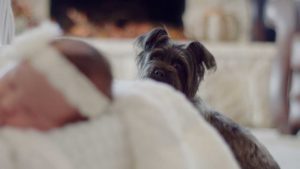
Introducing Your Newborn to Your Dog
It is a brilliant idea to let your children and a new dog meet before bringing the dog home. I know that there are times when we get excited to surprise our children with a puppy or a dog. But it is crucial to give them a chance to interact and ‘çhoose’ each other.
It is particularly important with an older dog.
It is also a FANTASTIC idea to introduce your potential new dog to existing pets that you have. You may be excited to take your dog home only to find out it has a taste for budgies or thinks that chewing on your 20-year-old family cat is a fun activity.
It may be that your newborn is not the first addition to your family. You may have other children including one or more fur babies that have been present with you before your current newborn enters the world.
Taking the necessary steps to ensure all goes well is crucial.
Many dogs will take instant love to your baby because they can see that you love them. But this may also come with some potential situations that you need to look out for.
Dusty would stare at Indi and loved to be close to her. I made sure I took the time to ensure she wasn’t going to sit on her, lie on her or try and join her in the pram.
Some dogs may be curious or a bit unsure and need some time to get used to the idea of a baby at home.
Some dogs (like my Mika) may be jealous that you have brought a little person into the family.
If you have a close relationship with your dog, it will already know from your pregnancy that something is happening. It will feel the feelings.
Training Your Dog Before the Baby
Nine months is a long time, plenty enough to iron out any issues or retrain any undesirable habits that you and your dog might have. It is imperative that you have control, respect and leadership with your dog.
The dog whisperer Cesar suggests that you reclaim your leadership throughout these nine months if you must, to ensure that you have control and your dog listens and obeys you. If you feel like you have to, you can hire a professional or attend obedience school to help you with this.
Nursery Boundaries
Take time to work with your dog to let them know that there are boundaries and expectations around the babies space.
My girl Dusty used to whimper at the door if my baby was waking and runs to get me. She would hassle me until I went (it was like having a four-legged baby monitor), but she would not enter the baby’s room without permission.
You may make the nursery out of bounds, and you have to train the dog not to go in there. It will take conscious effort and time from both of you, especially if your dog is a ‘follower’ or if they have been allowed in that space before.
If you are happy for them to go in, you can start allowing them to sniff and explore the room calmly and with your permission. Train them to enter when you allow it and leave when you ask.
Introduce Your Dog to the Baby Slowly
You may have to take ‘baby steps’ when introducing your newborn to your family pet. Start by bringing something home from the hospital, like a blanket or piece of clothing. Do not let your dog run straight up to it; this is about showing your leadership by teaching your dog that YOUR BABY’S SCENT BELONGS TO YOU.
Hold it up from a distance. Cesar suggests that you challenge the dog to sniff from a distance while you are holding the baby’s belongings first. You can then give your dog permission to sniff. If your dog runs right up to the item and tries to take or sniff it without permission, remove it, get out of the way and start again.
Remember, this is about control and leadership. Let your dog know that it must respect your rules around the baby because it belongs to you.

Training Your Dog Around the Baby
Bringing a baby into the mix of your household means that changes will happen around your dog. They will have to learn how to act around a baby, just as we humans do. Its routine will change, and you will spend your time differently. There will be different sounds and smells, and your dog will have to learn new skills and expectations.
Once again, this takes time, attention and commitment.
You may need to train your dog to obey some basic commands around your baby. Sometimes, all the new things their senses are picking up can excite, confuse or upset them. Spend time helping them to do the following things around your baby: sit, stay, lie down, drop (the baby’s toys!), leave things alone, calm/settle down.
Limitations of the Dog Around the Baby
Once again, this is about leadership. Your dog needs to obey the limitations that you set for
them for what is okay and not okay around your baby.
Some limitations may include no jumping, no rough play, no chewing of clothes or no play-biting on people.
One of the foremost things that I trained Dusty to do is not to jump and to rest calmly around children and the baby. She was a big dog. She was also a mixture of breeds that have a bad reputation in Australia. So this was to ensure that others would be calm around her as well because dogs tend to mirror people’s emotions and energy.
Make sure that you have a crystal clear command that signals a dog to stop doing something that you do not want it to do. It is a good idea to make this a general word that others can also use or will use as a reaction.
‘Stop’ or ‘No’ are two of the best and most obvious options.
It is not okay to keep your dog away from the baby by chaining it or locking it in a garage. Doing this can cause problems, and it is very cruel. If you take the necessary steps, your dog will more likely be very safe around your kids, and you may feel when they get older that they love the dog more than you!
Precautions to Take When Children and Dogs Are Together
Dogs can very quickly become a part of your family and contribute to your experience and happiness together. But it is important to never leave your children alone with your dogs, no matter how much you trust them.
We have put together a do’s and don’ts list to help keep things simple and keep you on track.
Do’s and Don’ts of Dogs and Babies/Children
In essence, here is a list of do’s and don’ts of dogs with a baby.
DON’T
- Leave your children alone with any dog.
- Introduce children to a dog that you do not fully trust and vice versa.
- Forget to consider the needs of both your family and the dog.
- Expect it to behave the way you want it to without time, care and training.
- Overlook any of the considerations that you need to make when choosing a dog.
- Forget to think of your plans and how this may affect your dog.
DO
- Take the time to ensure that you are the leader of the pack and you have respect and control over your dog.
- Ensure that you have ironed out any issues and bad habits your dog may have before bringing baby home.
- Introduce your child to the dog slowly.
- Support your children in being responsible pet owners and leaders.
- Choose a new dog for your family wisely. Consider the needs of both your dog and your family.
- Spend time training your dog around the baby if needed.
- Ensure your dog gets the love and attention it deserves.
- Enjoy the experience of having a dog.
How to Choose a New Dog for Your Family
It may be that a puppy or dog is the new addition to your family. CONGRATULATIONS TO YOU!
We can get excited about the idea of a cute little puppy running around with our kids and feel settled by the idea of having a friend that they can cuddle and love for many years.
However, you should not make these decisions on a whim.
There are some considerations that you need to make and some questions you need to ask yourself in order to ensure:
- You are ready to be a dog’s parent or own another dog.
- You choose an appropriate dog for your family.
- Your family is suitable for your choice of dog.
The following section is about helping you make sure you have all the right information and valuable knowledge, undertake adequate considerations and ask the right questions before considering or choosing a dog for your family.
Your family should meet with the potential new addition first to make sure you are right for each other.
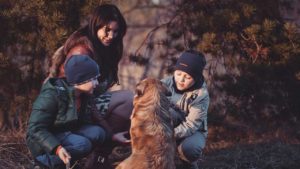
What Must I Know When Choosing a Dog for My Family
Know the History of Your Dog
It is vital that you know the history of the dog, the behaviours it has displayed, its temperament and if previous experiences with other humans have made it vicious.
Three particular experiences you must find out about are abuse, neglect and fighting. You will need to be cautious of or take special precautions when choosing to bring a dog with trauma around your children.
It is admirable to want to give that particular dog the love and life it deserves, but you must be very aware of how you will handle that dog and its potential triggers.
As an example, if your dog experienced abuse, it may growl, bite or protect itself if it feels that way again. A simple raising of a hand or a loud voice may send it into a tizzy or scare the poor thing.
If the dog was neglected or surrounded by lots of other dogs, it might not have grown used to being fed appropriately. It may have had to scavenge or fight for its food which can be dangerous if your children are close while it is eating.
If your dog used to be a caged dog or a fighting dog, it might not be trained to have gentle jaws and may have a more aggressive nature or behaviours if triggered.
Also, find the amount of contact the dog has had with people and in particular children.
It may not have socialised well and need extra care of provisions. It may be fearful or aggressive around children as they are unsure of what they are.
Early socialisation of a dog plays a big part in building their confidence. Some dogs may have missed out on this. Remedial socialisation may be possible, but that will take work, patience and effort. Are you prepared to do this?
Dogs have a lasting memory. They will act from experience unless you give the necessary provisions. My young cousin once chased my dog Mika with a high heel. She never forgot or forgave that particular girl even as she got older. Now, she isn’t keen on high heels unless they were on my feet!
Dog Family Health History
A health care professional asks you about any known illnesses or conditions within your family. You should do the same for your four-legged friend. It means that you can budget or prepare for any potential conditions that your dog is at risk of developing.
Understand the Needs and Potential Problems of the Breed of the Dog
Some breeds of dogs have a higher risk of acquiring certain conditions. For example, Labradors and German Shepherds are prone to obesity, Bulldogs can get breathing or respiratory problems, and Pugs can have eye irritations.
You must be ready to care for this and understand the associated cost and requirements that you may need to provide for and be able to afford.
My little Mika suffered from collapsing trachea which meant that she would splutter and cough and make horrible movements. I had to spend many hours comforting her as she got older. She also suffered hip and back pains which meant that I had to ensure that she did not lie on hard surfaces and cold tiles and only walked at a slow pace.
She also needed medical help with this condition. It meant that she became more expensive to keep and I had to care for her as she started to get slower in her older years. It is hard seeing your dog go through the aging process, so you need to be aware of what is to come.
Families rightfully become very attached to their dogs. Your dog becomes a member of your family. You will need to take time out to help your children learn how to support their dog, explain what is happening, support their emotions as these conditions occur and be ready to potentially get through a grieving process when your dog goes through bad times or passes away.
Test the Dog’s Temperament Around Your Children
DO THIS BEFORE YOU BRING THE DOG HOME TO YOUR FAMILY.
Some dogs have grown around adults but not children. For example, your dog may have been fine eating around you, but around kids, it may be a different story.
The dog you have chosen may have a soft and gentle temperament, but be very upset at your two-year-old’s high-pitched squeals and pestering.
We met with Diamond last week. She was gorgeous, but we had to ensure that she would be comfortable in our home environment. We also had to make sure that she could handle my kids’ general chatter and banter and carry on. We had to be 100 percent sure that Diamond would be happy to be loved by a boisterous two-year-old and a very affectionate four-year-old as well as us.
The Food Test
This one is vital.
It is crucial (especially if you have small kids that can slip out of your vision) that you test your dog around food. Some dogs can be very protective of it due to experience or as a trait.
It could be devastating if your small child wanders into their space or reaches into their bowl during meal time and the dog reacts aggressively. It is always good to check this potential trigger first.
Your Budget
You must be aware of your budget and if you can financially afford to have a dog. Dogs need to be cared for, just as humans do. They have needs such as food and medical care. Some of these expenses may get greater as the dog gets older. You may require professional trainers.
And of course, some dogs are more expensive than others. You need to be aware of your budget and how much money you can realistically put towards having a dog. And how about those surprise bills? You dog may get ill or develop a condition that needs extra financial support. They may have an accident and need medical care.
Dogs cost money. Does your budget allow for this?
Questions to Ask Yourself When Considering or Choosing a Dog
What Is the Purpose of Your Dog?
Do you want a dog that will share the fun in the sun, frolicking on the beach and fetching balls with your family? Or do you want a dog that can lounge about and act as a pillow and a familiar ear as your kids grow older? Do you want a dog that can protect the boundaries of your property? It is crucial to know the purpose of your puppy and dog.
Are you getting the dog for the right reasons? It is okay to be the only family on the street without a dog if it is not the appropriate time for you to get a dog yet. It is also okay to have a breed that matches your lifestyle compared to a high-maintenance breed.
Does the Dog Fit Your Lifestyle?
Dogs and families have their likes and dislikes and a particular set of needs. When considering the type of dog that is right for you, it is crucial to evaluate your current lifestyle and any potential lifestyle changes in the future to make sure that you can accommodate these and to ensure your dog will fit in nicely.
Travel
Are you a family that travels a lot or plans trips a lot? If this is the case,can you take it with you? For example, if you do a lot of driving and camping, do you have a car that your dog can fit in?
It may be that you travel interstate or overseas. You may be planning to move interstate or abroad in the future. You may have to check the laws in some states with particular dogs and requirements for quarantine.
It can be both devastating and expensive if you have a breed of dog that certain borders do not accept. If you can’t take your dog away with you on trips, do you have someone willing to care for your four-legged friend?
You may have to consider if there is a boarding kennel or doggy hotel near you (and check it out first to make sure it is up to standard).
How active are you and your family?
Do you want to take your dog to the beach or on runs with you? You may like to consider the breeds of dogs that best suit you.
I was an extremely active person and took my dog Dusty on all of my outdoor runs and outings. She was a dog that we got as a tiny puppy from a local indigenous family in our area. She was a Rottweiler/Sharpei/Pit Bull and needed to be active. My lifestyle suited her well.
My Mika (Pappilion) and Fatty (Border Collie/Staffy) were older by then and couldn’t keep up. I was able to cater for them by taking a specially designed carrier or making sure that I put time aside for them during the day and in the evening.
What Size Is My House/Yard?
If you live in an apartment, you may need to get a smaller, less active or even older dog. If you have a large house and property, you would be able to cater for a larger or more active dog.
What Is the Climate and Conditions of Where I Live?
Some dogs are just not built to live in certain climates. Bringing a long-haired dog like a husky into scorching temperatures is quite cruel. You may be on land full of prickles that would get stuck and matted easily in a Terrier’s coat.
You may need to consider a longer haired breed if you live in a colder zone.
Are You Prepared for a Long-Term Commitment?
Dogs aren’t a short-term commitment; some dogs can live close to two decades. It is a commitment for the life of that dog. The thought of a dog can be exciting, but you need to understand and be ready for the demands that come with having a dog become a part of your family.
How Much Time Do I Have to Spend with Your Dog?
Dogs need love, affection, care and exercise. They are not an ornament that hangs out and gets fed once a day. It is vital to their wellbeing for them to feel like they belong in our family. The more the dog feels like it is loved and belongs, the more of a trusting relationship you will build together. It will also help ensure a happy and loving experience for both the dog and your family.
Do you have time to groom, walk, run, play, cuddle, love, feed and take it to the vet? All of these things are crucial to consider.
Are You Prepared to Provide for Your Dog’s Needs?
Be realistic.
Some people find that although they like the idea of a fluffy (breed), they don’t feel like having to brush it’s hair every day and head to the dog groomers each week to maintain the dog’s coat.
Other people like the idea of a Border Coley, but live in an apartment block or don’t have the time or desire to exercise the dog as it needs. When choosing a dog, you need to be very clear on what your obligations are for the health and wellbeing of your family addition and if you are prepared to undertake them.
The only real time that I have gone without having a dog was recently after separating from my children’s father, moving interstate and then to Bali.
The only reason I didn’t get a dog for my children is that I wanted to move overseas, and my house didn’t have a yard big enough for a dog. I desperately wanted one but knew it would not be fair on the dog.
So given the first chance to move into our house in Bali, we started looking at rescue dogs. We now have Diamond, our sixth child. She was a breeding dog and is suffering from a mom bod and mom boobs like me. Diamond is one of the most gentle souls I have met, and she has fit straight into our family. She ticks all of the boxes, but we didn’t take her on lightly.
We went through a process to ensure we were going to be the best family for her and vice versa. Although there are many benefits to having a dog, introducing a dog to a new family is a big commitment and can be disastrous if the wrong family picks the wrong dog (and vice versa).
Do We Want a Pup or an Older Dog?
Puppies are gorgeous, and many of them start cuddly and docile. But remember, little puppies grow into bigger puppies and adolescent dogs, and these kinds of puppies and dogs require TRAINING.
Are you prepared for the time spent to train your dog not to eat your couch (and replace it or live with the damaged one)? Are you willing to devote time loving and welcoming the dog, toilet training, supporting its learning to walk on a lead, how to behave around other people and other animals?
How Much Will This Dog Cost to Keep?
A Great Dane can be heaps of fun and looks great riding around in a mini or walking your family to the shops, but they eat—A LOT!
An Afghan Hound is stunning and will turn heads on a Sunday outing, but their hair care is time-consuming and expensive!
Find out by asking someone who is a GOOD and RESPONSIBLE owner of that breed of dog to find out how much it costs and make sure it fits in your budget.
You may need a smaller dog or a short haired dog if you cannot keep up with its personal needs. Keep in mind food, hygiene, furniture, vet bills and pet insurance. These costs can mount up. It is critical that you find out how much your dog will cost you and ensure you can fit the bill.
Your dog may have medical conditions that you also need to care for as it gets older. You will also have to put some money aside in case of emergencies.
Are You Prepared for Your Dog to Get Old?
Just like humans, dogs get older. Their health deteriorates, and it can be hard not only emotionally but also financially. As their health needs increase, so to may vet bills and the supports that you need to provide for your once beautiful puppy.
You need to consider the emotional, time and financial requirements of an older dog if you want to introduce a new dog to your household.
I had to care for my Mika just as I would have an elderly citizen. She needed love, affection and extra care. You have to be ready to provide this, even when they reach their senior years.
What Breeds of Dogs Are Good With Children?
Lastly, remember to consider if your situation, living arrangement, plans and lifestyle are fair for the dog and it will enjoy being a part of your family.
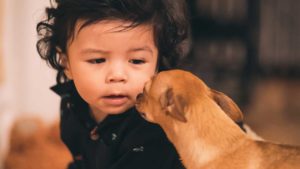
How to Help Your Child Be a Responsible and Great Dog Owner
Train your child to ‘listen’ to their dog.
There are a variety of things that you can do to support your child in caring for their pet and helping both the pet and the child to stay happy and safe.
A friend once told me that we should ‘train our kids as well as we train our dogs’, and I agree with her.
There are unfortunate cases of dogs severely injuring children, and it causes dismay, hurt and turmoil in the family.
The child and the dog may have been best friends, went everywhere together, played together and slept together.
Dogs have buttons that you might accidentally push, and just like us, sometimes their fuse snaps. So even if you have a very friendly or tolerant dog, it is crucial that the entire family knows and understands your dog and is aware of the signals that your dog is giving you about how they feel.
Let them be involved with the care of the dog.
You may like to give age-appropriate tasks to help care for the dog and let your children be involved with you as you wash them, walk them, etc.
Older kids can start taking on these tasks on their own. My four year old has taken in on herself to prepare Diamond’s food bowl. We do check to make sure that she isn’t overfeeding her or stealing too much of Diamond’s chicken and pumpkin casserole.
Give your dog a break.
Dogs can be your child’s best friend. They sometimes make for great entertainment to give you a break. Just as you sometimes feel like you need a break from your child/ren, your dog may get the same. It is especially true if your child is around them all the time and allowed to follow, play with and touch the dog.
I read about a terrible instance where parents left a baby alone with a babysitter to have a ‘break’, and the baby was allowed to crawl around after their dog from corner to corner, grabbing, pulling and patting.
Most people would turn around annoyed, yell and lash out at this after a while. A dog may do the same. And dogs snarl, growl and sometimes bite. So make sure your dog can have some peace and space on its own sometimes.
You can approach this by explaining to your children in ways that they will understand.
Worm Together.
This one is a little hint from a mom who has had dogs and kids and has learnt from experience. When worming, worm together! Make it a whole family experience. There is no point worming one and then the other a few weeks later. It gives the worms a chance to jump ship and spread.
Never leave the kids alone—even if you trust the dog.
A dog also needs to be comfortable and enjoy its time with you as much as you enjoy having a dog. If you are bringing a baby into a family that already has a dog, take time and have the patience to introduce them.
Some dogs will adore your baby right away (like Dusty); others will take a bit more time (my poor old Mika was cranky that I kept bringing other animals and then a child into her space). Just like humans, some dogs need to get used to change.
If we are bringing a dog into our family, it is crucial that the dog chooses us as much as we choose it. We need to set realistic expectations. Also, we need to accept the responsibilities and realities of having a dog become one of your family members.


